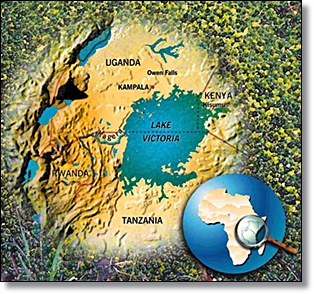Lake Victoria: On Its Death Bed?

 |
| Lake Victoria Photo courtesy |
The declining water levels coupled with the use of agro-chemicals such as Calcium Ammonium Nitrate, Ammonium Sulphate and Urea by farmers around these rivers is choking fish populations in the lake.
My investigation on pollution and municipal waste management in cities and towns around Lake Victoria such as Kisumu, Kenya, Mwanza, Tanzania, Kampala and Jinja-Uganda, reveals that the many chemical industries which these towns house discharge raw effluent into the Lake. Many of these towns are not connected to their national central sewerage systems, as thus, the untreated waste products including human waste are discharged directly to the Lake. In addition, most of the wetlands around the Lake, are being cleared for agricultural purposes and paving way for uncoordinated buildings. What is happening around Nakivubo channel in Bugolobi wetland in Kampala, Uganda, is a good example of the increasing health hazard.
All this is happening, under the watchful eyes of Lake Victoria Environmental management programme (LVEMP), Lake Victoria Fisheries Organisation (LVFO), National Environment management Authorities in East Africa, National water and sewerage corporations, and a host of Non-government organizations mandated to improve environmental conditions of the Lake and its catchment areas, ensure that Lake resources are used in a sustainable manner, control water hyacinth.
Why aren’t these organizations executing their mandate? What can be done about it?
Lake Victoria, the second largest fresh water Lake in the world on which over 30milion people across East Africa derive their livelihood and is contributing to the development of East African economies through fish exports amounting to $350-$420 annually must be conserved.
Fishing of immature fish is rampantly going on, contributing to fish declines and possible extinction of some fish species. While beach management units personnel and other bodies are charged with fighting this vice, many of them happen to be fishermen who are indirectly involved in the practice and solicit bribes from fishermen engaged in the vice.
People who have settled near river banks and in wetlands that drain water into Lake Victoria ought to be relocated. All factories that are built along the channels that drain their water into the Lake and have no proper disposal and water treatment facilities must be shut. Those caught fishing immature fish, should, have their licenses, suspended say for a period of 10 years. This should be done in uniformity across the region.
East African governments, media in East Africa, the above mentioned organizations particularly LVEMP and LVFO, communities living around the Lake and its catchment areas including the industrialists should work hand in hand to protect Lake Victoria and ensure its sustainability.
By Moses Hategeka
The author Ugandan based independent governance researcher, public affairs analyst and writer.
